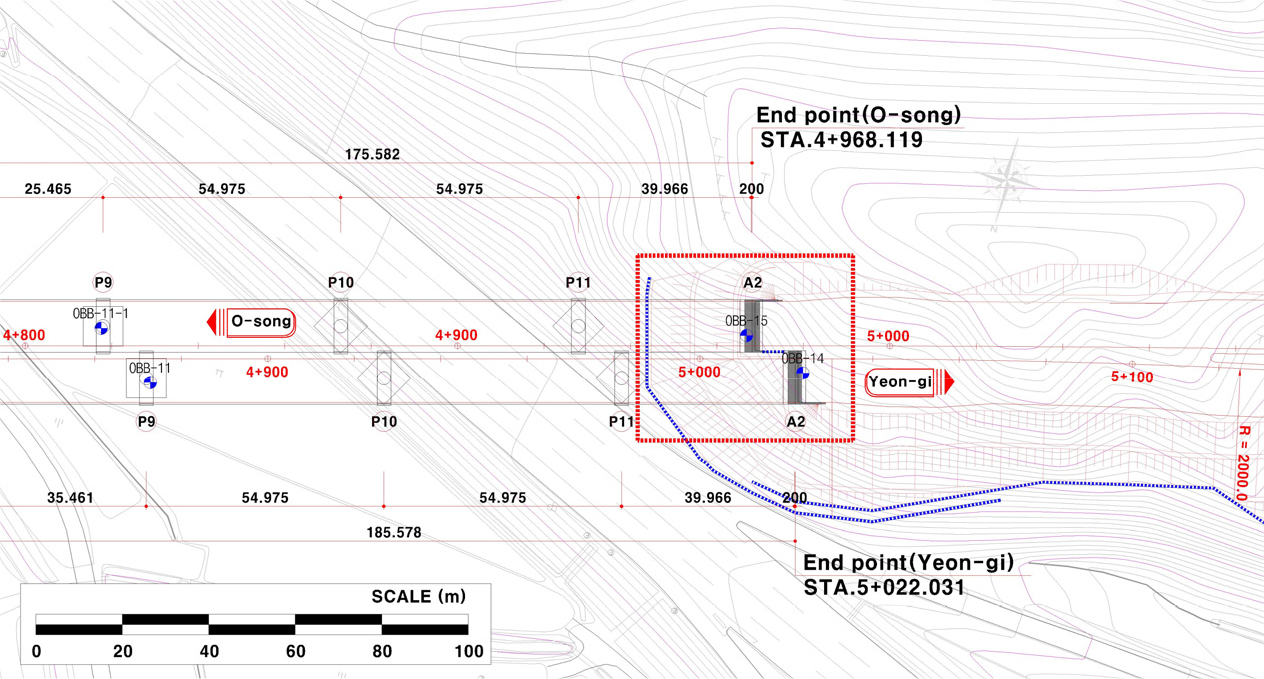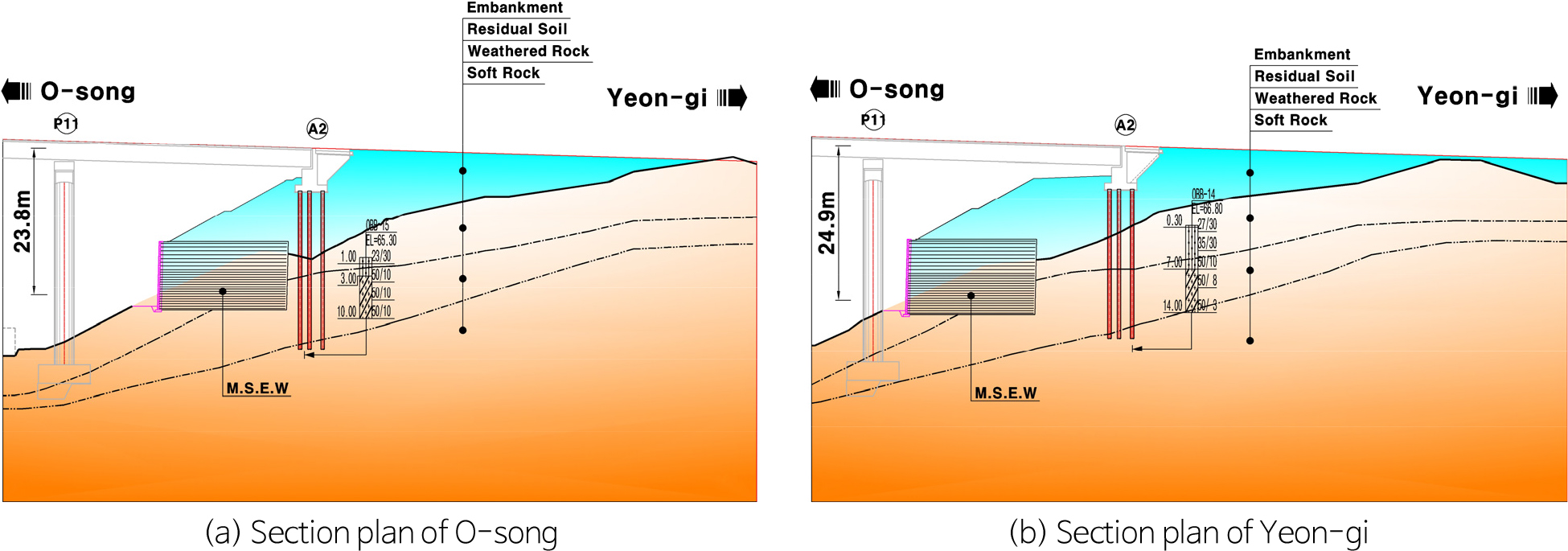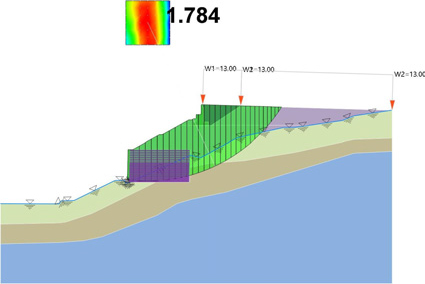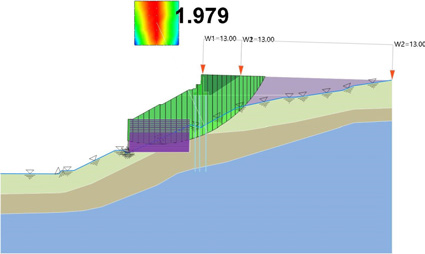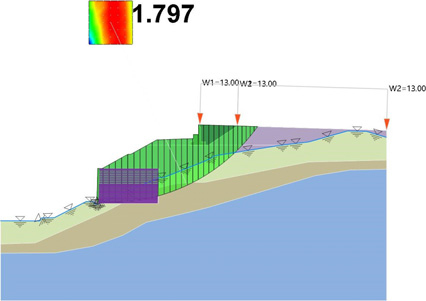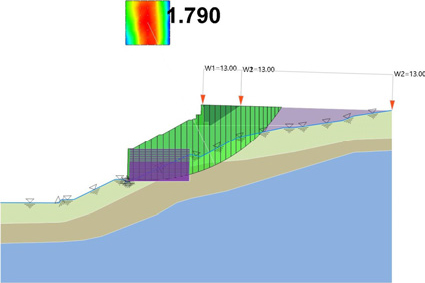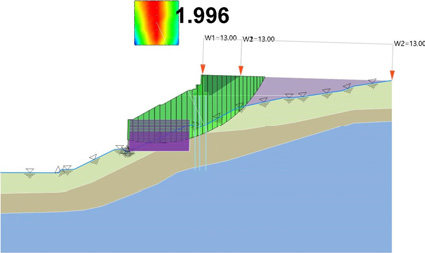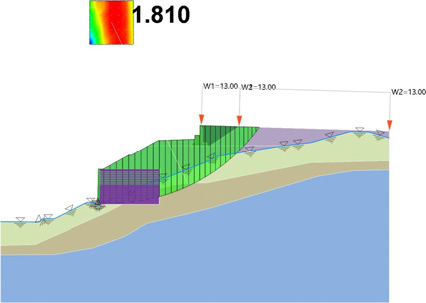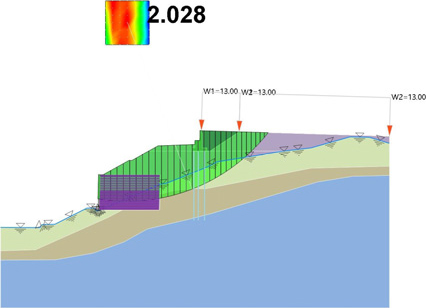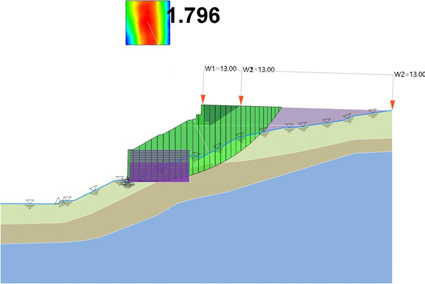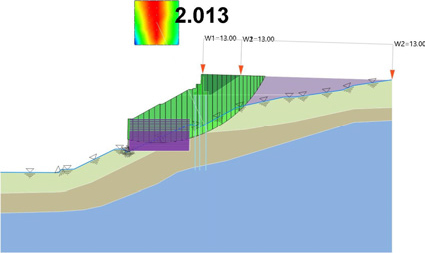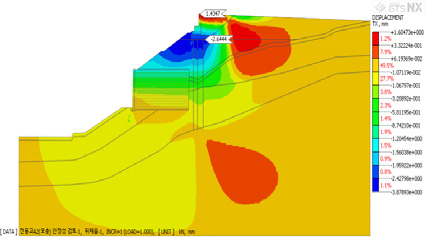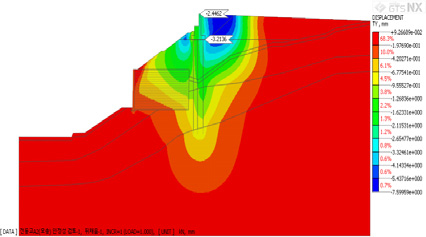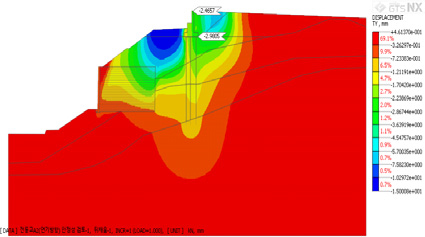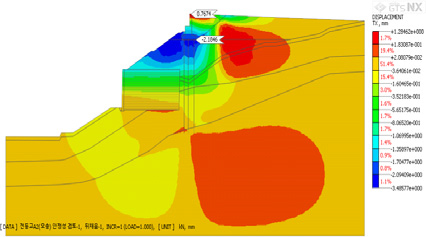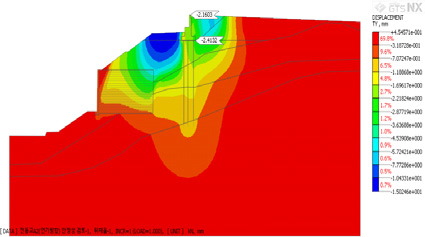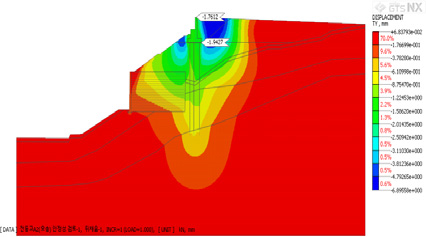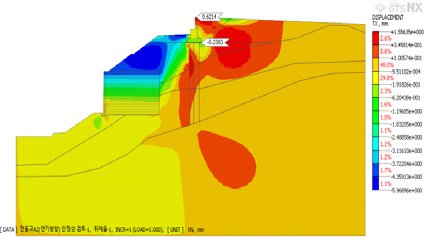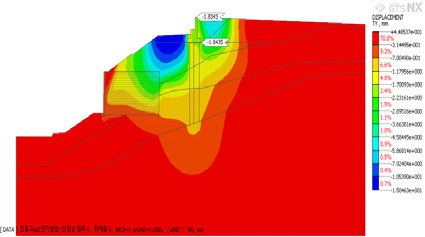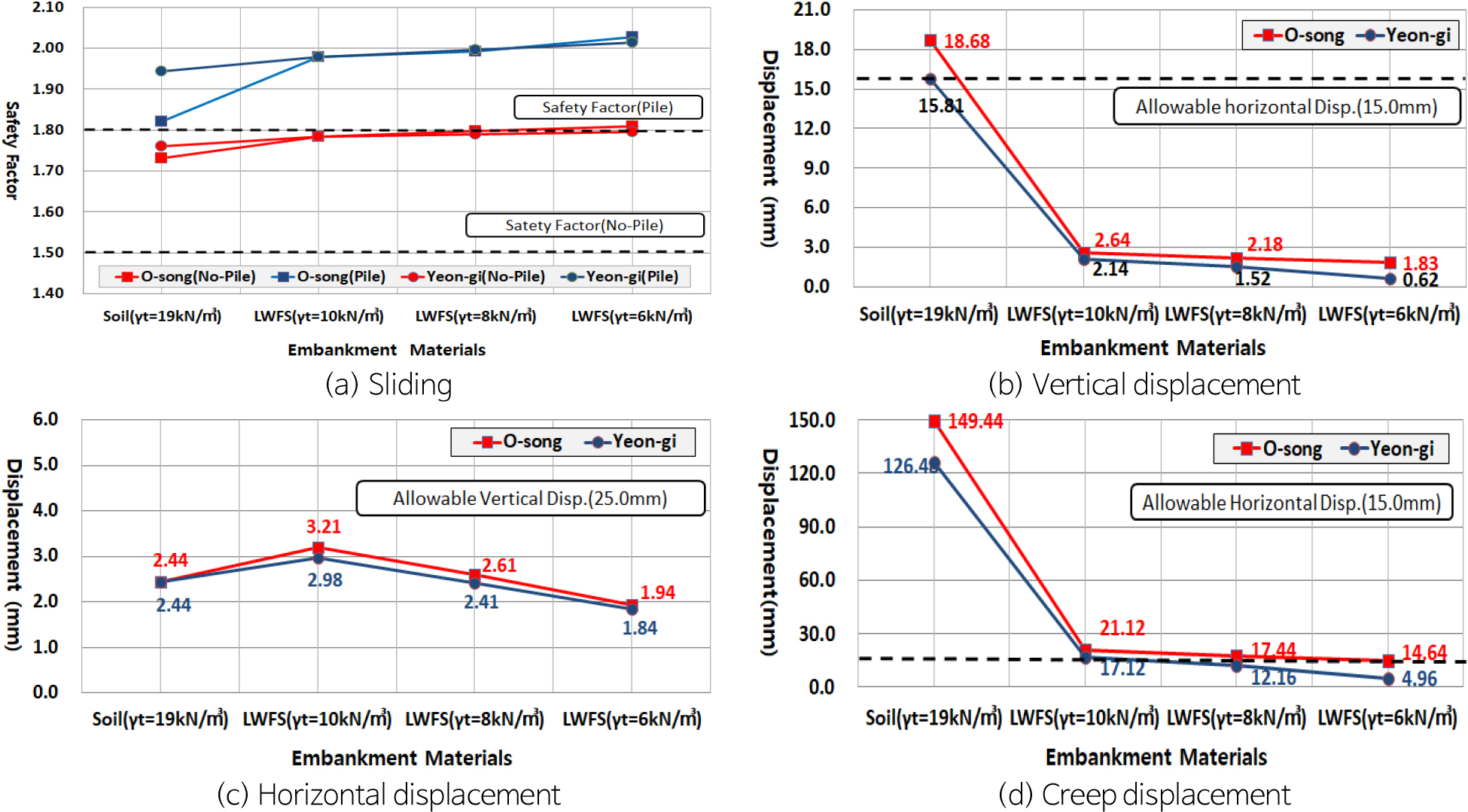서 론
대상 교량 현황 및 설계기준 검토
대상 교량 현황
설계 기준
설계 지반정수
교대 안정성 검토
교대 시공 순서
일반 성토재를 이용한 교대 안정성 검토
경량기포토를 이용한 교대 안정성 검토
결 론
서 론
최근 고속도로 및 국도 건설에 있어 산악지를 통과하는 도로 건설의 경우 대규모 절토 및 성토가 발생된다. 특히, 교량구간의 경우 급경사지에 위치하게 되어 불가피하게 고성토부에 교대가 위치하게 되며, 성토 제체의 안정 뿐 아니라 교대 뒤채움시 측방 토압에 의한 교대의 수평변위 발생으로 신축이음, 교대 구체 및 받침 파손, 유간 협착 등 교량구조물의 안정성이 저하되고 있는 실정이다(Seol et al., 2015; Nam et al., 2017).
교대의 수평변위 발생에 대한 연구는 연약지반상의 하중분포와 크기에 따른 변형 연구는 Hong(1994), Seo et al.(2001), Tschebotarioff(1973) 등에 의해 발표되었으며, 일반 성토 사면에 시공된 교대의 변형 연구는 Lee(2013a), Kwon(2014) 등에 의해 발표되었다.
특히, 최근에 발표된 교대 수평변위 원인과 대책방안 연구(Ⅱ) (KECRI, 2013)에 의하면 기존 설계에서는 교대의 수평변위는 뒤채움재의 탄성변위를 고려하고 있으나, 뒤채움 시공 후 시간 경과에 따른 성토재 및 뒤채움재의 Creep 변위 발생으로 장기간에 걸친 변위가 발생되는 것으로 보고되고 있다.
교대의 경우 벽체와 슬라브 사이의 온도 신축 변형 등에 대응할 수 있도록 유간을 설치하고 있으나, 교대 배면 뒤채움재의 토압에 의한 수평변위 발생시 유간 협착에 의한 구조물 파손, 주행성 불량 등으로 이어질 수 있다.
교대의 뒤채움 하중을 경감시키기 위한 대책으로는 최근까지 EPS공법, Pile Slab, 경량 성토, 전면 압성토 등의 다양한 대책안이 수립 ‧ 시공되고 있다. 이러한 하중 경감공법 중 시공성 및 토압을 경감시킬 수 있는 EPS 공법이 최근까지 종종 사용되어 왔으나, EPS가 갖는 소성변형에 의한 침하, 중차량 주행시 진동, 내화성 및 내식성 부족 등으로 점차 사용 빈도가 감소하는 추세이다(Lee, 2013b).
따라서, 본 연구에서는 장기적인 Creep 변위를 고려하여 수평변위를 감소시킬 수 있는 경량기포토를 적용하여 수치해석적 방법으로 교대의 안정성을 분석하였다.
대상 교량 현황 및 설계기준 검토
대상 교량 현황
본 연구에서 적용된 현장은 고속국도 제○○○호선 세종-포천 고속도로 건설공사 ○공구에 위치한 전동교 교대 A2 구간이다. 본 교량은 총 연장 555.1 m의 DR거더교로 교대의 높이는 7.0 m, 최대 성토높이는 23.8~24.9 m이다. 교대 기초는 매입강관말뚝(φ609, L = 19.9~25.7 m)으로 계획되어 있으며, 말뚝이 위치하는 지반의 지층은 성토재, 풍화토, 풍화암, 연암으로 구성되어 있다. 교량 현황 및 지층 구성 현황은 Fig. 1, Table 1과 같고, 방향별 단면은 Fig. 2와 같다.
Table 1.
Specifications of Jeon-Dong bridge abutment-2
설계 기준
성토부에 시공되는 교대의 경우 일반적으로 말뚝기초 형식으로 계획되며, 성토제체의 활동, 교대 뒤채움재의 토압에 의해 수평변위가 발생하게 된다. 현재까지 제시된 수평변위에 대한 기준은 Table 2와 같다.
Table 2.
Standard criteria for allowable horizontal displacement of piles (domestic and international)
| Guideline | Allowable horizontal pile displacement (mm) | |
| Domestic | Highway Bridge Design Standard (MOLIT, 2012) | ≤38.0 mm |
| Foundation Structure Guideline (MOLIT, 2018) | ≤15.0 mm | |
| Road Design Manual (KEC, 2023) | ≤1.0% of pile diameter or 15.0 mm | |
| International | AASHTO LRFD Bridge Design Specifications (AASHTO, 2012) | ≤38.0 mm |
| Canadian Foundation Engineering Manual (CGS, 2006) | ≤1.0% of pile diameter | |
한편, 최근 연구 자료에 의하면 교대의 수평변위에 영향을 미치는 인자는 Table 3에 제시하였다(KECRI, 2013).
Table 3.
Factors influencing horizontal displacement of abutments
상기의 교대 수평변위 발생 영향 인자 중 정량적 인자는 지형조건, 성토조건, 기초조건, 교대조건 등이며, 정량적 인자에 대해서는 탄성해석을 통한 수평변위를 산정할 수 있다. 그러나, 시공 중 발생되는 오차 및 지반의 크리프 현상으로 인한 정성적인 부분에 대해서는 수평변위를 산정할 수 없어, 시공 후 교대 뒤채움에 따른 변위 양상이 기존 탄성해석에서 얻어지는 수평변위량과 큰 차이를 보일 수 있다.
따라서, 지반의 크리프현상에 의해 발생되는 교대의 수평변위를 고려하기 위하여 계수가 제안되었으며, 이를 통한 교대의 설계 기법이 연구되었다(KECRI, 2013). 크리프 특성을 고려한 설계기준은 Tables 4 and 5와 같다.
Table 4.
Creep coefficient of embankment height
| Embankment height (m) | Creep coefficient | Section |
| ≤10 m | 0.50 | 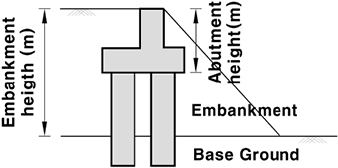 |
| 10~15 m | 1.00 | |
| 15~25 m | 1.50 | |
| ≥25 m | 2.00 |
Table 5.
Creep coefficient for the pre-loading period
| Embankment height (m) | Creep coefficient | ||
| No pre-loading | 3 months pre-loading | 6 months pre-loading | |
| ≤10 m | 4.00 | 0.50 | 0.06 |
| 10~15 m | 7.00 | 1.00 | 0.50 |
| 15~25 m | 8.00 | 1.50 | 0.65 |
| ≥25 m | 12.00 | 2.00 | 1.00 |
상기 Creep 변위 기준과 허용 수평변위를 고려한 설계기준은 Table 6과 같이 적용하였다.
Table 6.
Application design criteria
| Embankment height (m) | Allowable horizontal displacement (mm) | Creep coefficient (no pre-loading) | Note |
| ≤10 m | 15.00 | 4.00 | |
| 10~15 m | 15.00 | 7.00 | |
| 15~25 m | 15.00 | 8.00 | Selected |
| ≥25 m | 15.00 | 12.00 |
설계 지반정수
본 연구를 위하여 원지반 및 성토제체의 지반정수를 산정하였으며, 산정 결과는 Table 7과 같다.
Table 7.
Design soil and rock properties
교대 안정성 검토
교대 시공 순서
연구대상 교량의 경우 거더 런칭 기간 부족에 따라 Creep 변위를 감소시킬 수 있는 프리로딩이 불가한 상태이다. 따라서, 프리로딩 미고려시 장기적인 교대의 수평 안정성을 검토하였다. 연구 대상 교량의 시공순서도는 Fig. 3과 같다.
일반 성토재를 이용한 교대 안정성 검토
교대 쌓기부의 안정성 검토를 위한 교대의 활동안정성 검토는 한계평형해석 프로그램인 Midas SoilWorks를 이용하였으며, 교대 변위 파악을 위한 프로그램은 유한요소해석 프로그램인 Midas NX를 사용하여 2차원 해석을 실시하였다. 검토결과는 Figs. 4 and 5, Table 8과 같다.
Table 8.
Results of displacement analysis
경량기포토를 이용한 교대 안정성 검토
고성토 교대부에 대해 일반 성토재를 적용하여 뒤채움 시공시 뒤채움 토압에 의해 교대의 안정성이 확보되지 못하는 것으로 검토되었다. 따라서, 일반 성토재에 비해 하중이 작아 토압을 경감시킬 수 있는 경량기포토를 적용하여 교대의 안정성을 검토하였다.
교대부에 적용되는 경량기포토를 이용한 교대 뒤채움재로의 적용성은 Lee(2013a), Do et al.(2021)에 의해 연구되었으며, 압축 및 강도 특성은 Yoon and Kim(2004), 진동 및 지진안정성은 Park et al.(2021)에 대해 연구되었다. 특히, 경량기포토의 배합기준에 따른 단위중량 변화와 일축압축강도, 변형계수의 관계 등은 Kim(2010)에 의해 연구되었다. Kim(2010)에 의해 제안된 경량기포토의 재료특성은 Table 9와 같다.
Table 9.
Material properties of light-weighted foam soil
경량기포토를 적용한 교대의 안정성 검토결과는 Tables 10, 11, 12와 같다.
Table 10.
Stability analysis of Jeon-Dong bridge abutment-2 (light-weighted foam soil)
Table 11.
Displacement analysis of Jeon-Dong bridge abutment-2 (light-weighted foam soi
Table 12.
Displacement analysis results (light-weighted foam soil)
경량성토재를 이용한 교대 배면 뒤채움시 교대 변위 검토 결과 발생변위는 허용변위 이내이나, Creep 변위를 고려할 때 허용변위의 약 0.33~1.41배의 변위가 발생되는 것으로 검토되었다. 한편, 경량성토재 단위중량이 γt = 6.0 kN/m3를 적용할 경우에는 변위 발생이 크게 감소하여 모든 구간에서 교대 변위 안정성이 확보되는 것으로 검토되었다.
Fig. 6에 제시된 바와 같이 일반성토재와 경량기포토를 적용한 교대의 안정성을 비교 검토한 결과 성토재료에 따른 교대의 활동안정성은 큰 변화를 보이지 않으나, 수평변위의 경우 경량기포토 적용시 일반성토재 발생변위의 약 3.9~14.1%로 감소되는 것으로 검토되었다.
결 론
본 연구는 도로 시공시 고성토부에 시공되는 교량의 교대부에 대한 수평변위 저감대책으로 경량기포토를 이용한 교대의 안정성을 검토하였다. 기존 설계에서는 교대의 안정성 검토시 교대 뒤채움시 발생되는 토압에 의한 탄성변위를 고려한 설계가 진행되어 왔으나, 최근 성토재 및 뒤채움재의 Creep 변형을 고려한 장기변형에 대한 연구가 진행됨에 따라 장기 변형을 고려한 교대의 안정성을 검토하였다.
연구 결과 일반성토재(γt = 19.0 kN/m3)를 교대 뒤채움 재료로 사용시 교대 활동안정성은 방향별로 Fs = 1.732~1.761 (말뚝 미고려시, Fs > 1.500), Fs = 1.820~1.943 (말뚝고려시, Fs > 1.800)로 활동안정성이 확보되었으며, 교대의 수평변위는 방향별로 15.81~18.68 mm (Creep 미고려시, 15 mm 이내), 126.48~149.44 mm (Creep 고려시, 15 mm 이내)로 허용변위 이상으로 크게 발생하여 교대의 안정성이 확보되지 못하는 것으로 검토되었다.
경량기포토(γt = 8.0~10.0 kN/m3)를 교대 뒤채움 재료로 사용시 교대 활동안정성은 방향별로 Fs = 1.784~1.797 (말뚝 미고려시, Fs > 1.500), Fs = 1.979~1.996 (말뚝고려시, Fs > 1.800)로 활동안정성이 확보되었으며, 교대의 수평변위는 방향별로 1.52~2.64 mm (Creep 미고려시, 15 mm 이내), 12.16~21.12 mm (Creep 고려시, 15 mm 이내)로 허용변위 이상으로 크게 발생하여 교대의 안정성이 확보되지 못하는 것으로 검토되었다.
경량기포토(γt = 6.0 kN/m3)를 교대 뒤채움 재료로 사용시 교대 활동안정성은 방향별로 Fs = 1.796~1.810 (말뚝 미고려시, Fs > 1.500), Fs = 2.013~2.028 (말뚝고려시, Fs > 1.800)로 활동안정성이 확보되었으며, 교대의 수평변위는 방향별로 0.62~1.83 mm (Creep 미고려시, 15 mm 이내), 4.96~14.64 mm (Creep 고려시, 15 mm 이내)로 허용변위 이내로 교대의 안정성이 확보되는 것으로 검토되었다.
일반성토재와 경량기포토 적용시 교대의 활동안정성은 큰 변화를 보이지 않고 있으나, 뒤채움 토압 감소에 따라 수평변위는 일반성토재 적용시의 약 3.9~14.1% 수준으로 감소되는 것으로 검토되어 교대 뒤채움 재료로 경량기포토의 적용이 가능한 것으로 검토되었다.
한편, 본 연구에서는 교대 및 성토 높이, 구성 지반의 한계성 등 제한된 자료를 통해 검토된 연구 결과이므로 향후 다양한 조건에서의 연구가 진행되어야 할 것으로 판단된다.
또한, 본 연구 결과는 교대의 탄성 변위 및 장기적인 Creep 변위를 고려한 교대 안정성 검토시 주요 참고자료로 활용될 수 있을 것으로 기대된다.



